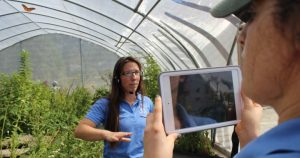
By Jeff Hoagland, Kathy Browne, and Sandra LaVigne
Informal Science Education (ISE) professionals from Stony Brook Millstone Watershed Association and the Great Swamp Watershed Association partnered with K-12 teachers from New Brunswick Public Schools and the School District of the Chathams to create civic-issue focused middle and high school curricula. The project was facilitated by a geologist from Rider University who is both a SENCER model course author and an active provider of professional development to K-1 teachers focused on the Next Generation Science Standards. Together this group designed NGSS-aligned lessons that are focused on environmental issues in surrounding communities selected by the partnered teams.
All planned work was completed on time: draft lessons were completed in spring 2017; teachers and appropriate ISE staff members tested them with students by June 2017; observations of lessons and review of student artifacts enabled the ISE/teacher pairs to revise the lessons in summer 2017.
Final units are now available for both teachers and ISE organizations to use and share. One sample lesson is “Swamped! Mitigating Local Runoff to Protect Our Waters,” where students learn about the impact of impervious surfaces on runoff and water quality in their local community and identify ways community members can reduce their impact. Another lesson is “Human Impact–School Redesign” where students learn about methods to mitigate impact of buildings and human activity through explorations at a LEED-certified building then identify issues within their school building that affect the outside community or world. The units will soon be submitted for consideration of the SENCER’s Model Series.
Observations of middle school and high school student presentations that resulted from the teacher/ISE teams’ work indicate that young learners gained an appreciation for the value of applying their science learning to addressing real local issues. The middle school students proposed solutions to numerous inefficiencies in their school building and their principal reported to them that he could implement some of them! High school students made recommendations for adjustments to community member behaviors to reduce local watershed pollution.
The project had a great impact on everyone involved. ISE professionals directly involved in the project met their goal of becoming better informed about the NGSS and experienced in collaborating with K-1 teachers to design a program that meets the teacher’s needs. K-12 teachers directly involved are better informed about the intent of the NGSS, in particular the engineering design components and the expectation that the design process be used to learn or apply science concept understandings. They have a very successful lessons sequence that they plan to use again. And they have deepened their understanding of some of the science related to the phenomena and issues addressed in the lessons. The higher education faculty member gained greater insight into implementing the NGSS specifically with a focus on civic issues. This experience will enable her to work with additional teachers and has been invited to do so with at least one district in NJ in spring 2018. She has also been invited to provide similar professional development to a group of undergraduate NOYCE scholarship recipients in spring 2018. These undergraduates are aspiring high school science and mathematics teachers.
*
This work was part of a project funded by a sub-award provided by SENCER-ISE through the project, Partnership Champions: SENCER ISE and Professional Development Through Mentoring to Enhance Learning Environments (MG-10-15-0071-15A). Partnership Champions is funded by the Institute of Museum and Library Services.
Photograph provided by project partners features Allison Jackson, SBMWA staff, giving a presentation for students.
